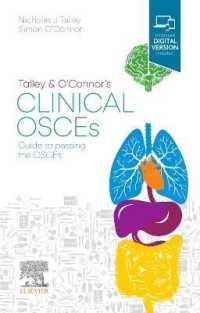Full Description
This book provides police investigators and homicide detectives with a practical method of analyzing 911 homicide calls to uncover the truth. A structured analysis of 911 homicide calls can directly aid in developing investigative leads, planning interviews, and solving cases. Case examples provide practice in analyzing calls to determine the likelihood of the caller's innocence or guilt. Every member of the investigative team, from call-taker to first responder, investigator, coroner's investigator, and prosecutor, can contribute to the success of investigations through their knowledge of 911 call analysis.
Contents
Dedication
Acknowledgements
Authors' Note
Foreword
Part 1: Introduction
Chapter One: The Critical Value of 911 Call Analysis
Chapter Two: Case Study: Mr. and Mrs. Hunt
Part 2: Who Is the Call About?
Chapter Three: Does the Caller Demand Help?
Chapter Four: Does the Caller Provide an Immediate Assessment of the Victim?
Chapter Five: Who is the Caller's Focus?
Chapter Six: Does the Caller Accept the Victim's Death?
Chapter Seven: Does the Caller Provide Aid to the Victim as Directed?
Part 3: What is the Call About?
Chapter Eight: Is the Information Relevant?
Chapter Nine: How Does the Caller Describe the Situation?
Chapter Ten: How Does the Caller Prioritize the Information?
Chapter Eleven: How Does the Caller Describe the Conditions?
Part 4: How is the Call Made?
Chapter Twelve: Does the Caller Express Urgency or No Urgency?
Chapter Thirteen: Is the Caller Fearful?
Chapter Fourteen: Is the Caller in Close Proximity to the Victim?
Chapter Fifteen: Does the Caller Begin with Initial Sounds or Initial Delays?
Chapter Sixteen: Does the Caller Use Aggressive Demands or Passive Defenses?
Chapter Seventeen: Does the Caller Show Cooperation with Dispatcher or Resistance to Dispatcher?
Part 5: Independent Guilty Indicators
Chapter Eighteen: Attempts to Convince
Chapter Nineteen: Awkward Phrases
Chapter Twenty: Conflicting Facts
Chapter Twenty-One: "Huh?" Factor
Chapter Twenty-Two: "I Don't Know"
Chapter Twenty-Three: Isolated "Please"
Chapter Twenty-Four: Lack of Contractions
Chapter Twenty-Five: No Modulation
Chapter Twenty-Six: Unexplained Knowledge
Chapter Twenty-Seven: Indicators Trending Toward Guilty
Part 6: The Big Picture
Chapter Twenty-Eight: Does the Call Match the Scene?
Chapter Twenty-Nine: Create a Timeline: Murder Does Not Happen in a Vacuum
Part 7: 911 Analysis Tips for the Law Enforcement Team
Chapter Thirty: 911 Analysis Tips for Dispatchers
Chapter Thirty-One: 911 Analysis Tips for Patrol Officers
Chapter Thirty-Two: 911 Analysis Tips for Investigators
Chapter Thirty-Three: 911 Analysis Tips for Prosecutors
Chapter Thirty-Four: Case Studies
Epilogue
Appendices
Appendix A: Case Study Analyses
Appendix B: Glossary of Terms
Index
-

- 電子書籍
- へい!お待ちっ!10
-

- 電子書籍
- GENROQ 2016年7月号 GEN…






